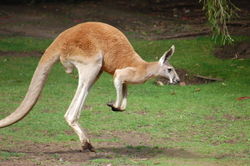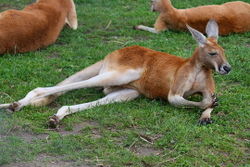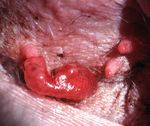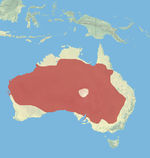Red kangaroo
| Red kangaroo |
|---|

|
| Scientific Classification |
|
| Binomial Name |
|
Macropus rufus |
| Image Description |
The Red Kangaroo is a species of kangaroo known by the scientific name Macropus rufus. They are perhaps best known as the largest living marsupial in the world, and an iconic Australian animal.[2]
Body Design
Red kangaroos hop fast on their powerful hind legs. A Red Kangaroo may reach speeds of over 35 miles (56 kilometers) per hour. Their bounding gait-a manner of walking, stepping, or running, allows them to cover 25 feet (8 meters) in a single leap and to jump 6 feet (1.8 meters) high. Female Kangaroos are smaller, lighter, and faster than males. Males tend to be reddish-orange while females are mainly bluish-gray. Red kangaroos can be recognized by their black and white patches on their cheeks. The long white stripe that stretches from the corner of the mouth to ear, which other types of kangaroos don't have. The body length for male Red Kangaroo is up to 1.4m and for females it is up to 1.1m [3] [4] [5]
Life Cycle
Females have only one baby at a time, which at birth is about the size a jellybean or pea. The mother licks a saliva path which the baby follows into the pouch where it may stay for up to 10 months. All female kangaroos have teats-the protuberance on the breast or udder in female mammals, except the monotremes, through which the milk ducts discharge; nipple or mammilla, in their pouches. Up until eight months of age, young kangaroos, called joeys, will quickly dive into the mother's pouch in case of danger. Red Kangaroo males will challenge each other for mating opportunities with several females. A female Red Kangaroo is usually mature at about 15-20 months. However some Red kangaroos are still not mature by 4 years old. Once mature a female red kangaroo produces about three joeys every two years. Red kangaroos have a short gestation period lasting only 33 days. A Red kangaroo's life span is about 12-15 years. Female red kangaroos stay with their natal-of or relating to a person's birth, group but the males leave when they are fully mature. [6] [7] [8]
Ecology
Red Kangaroos primarily live in the deserts and open grasslands of Australia but they are also found in New Zealand. These kangaroos eat Primarily green grass and herbage, and when they eat it is mainly at night. Majority of its water is satisfied by the water it gets from eating vegetation. They can go without water for a long period of time. The Red Kangaroo naturally has very few predators. More commonly is the Dingo, a dog like animal. Joeys may be prey to eagles and foxes. Humans are the main predator for adult Red Kangaroos. Sheep farmers will sometimes (often) shoot (mainly all types) Red Kangaroos on sight because they are on the same land their sheep are. People will also kill kangaroos for meat and will export it all over the world.[9][10]
name
The Kangaroo's family name, Macropodidae, means "big feet," a great description for Kangaroos and their relatives.
Video
Baby red kangaroo (joey) jumping out of pouch
References
- ↑ Macropus rufus Wikispecies. Web. last modified on 1 December 2010. Author Unknown
- ↑ Carter, Luise. Animal Species:Red Kangaroo, Macropus rufus australian museum. Web. 3 March 2014 Last updated.
- ↑ Schersche, Joseph. Red Kangaroo National Geographic. Web. Date-of-publication or last-update or access (specify which).
- ↑ Carter, Louise. ANIMAL SPECIES:Red Kangaroo, Macropus rufus Australian museum. Web. 3 March 2014 Last updated.
- ↑ Authorlastname, Firstname. Page-Title Publishing-site-name. Web. Date-of-publication or last-update or access (specify which).
- ↑ Site designed by Play, a VTA Company. Kangaroo, Red Atlanta Zoo. Web. Last update 2014.
- ↑ Scherschel, Joseph Red Kangaroo National Geographic. Web. Last update 2015.
- ↑ Red Kangaroo Denver Zoo. Web. Accessed 25 Jan 2015.
- ↑ Authorlastname, Firstname. Red Kangaroo Billabong Sanctuary. Web.
- ↑ Authorlastname, Firstname. Red Kangaroo National Geographic. Web.




